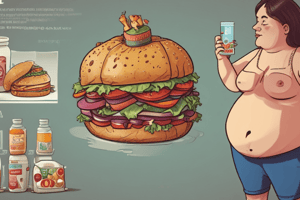Podcast
Questions and Answers
What is the approximate body fat percentage for healthy women?
What is the approximate body fat percentage for healthy women?
- 15-20%
- 20-25%
- 25-30% (correct)
- 30-35%
How many risk factors for CHD are related to diet?
How many risk factors for CHD are related to diet?
- Five
- Four (correct)
- Two
- Three
What is the strongest risk factor for liver cancer?
What is the strongest risk factor for liver cancer?
- Alcohol (correct)
- Diabetes
- Obesity
- Red and processed meats
What is the third leading cause of cancer mortality in men and women?
What is the third leading cause of cancer mortality in men and women?
What was the focus of the first phase of nutrition science in the 20th century?
What was the focus of the first phase of nutrition science in the 20th century?
What is the primary advantage of maintaining a desirable body weight throughout life?
What is the primary advantage of maintaining a desirable body weight throughout life?
What is the formula to calculate BMI with pounds and inches?
What is the formula to calculate BMI with pounds and inches?
In which type of individuals may a normal BMI conceal underlying excess adiposity?
In which type of individuals may a normal BMI conceal underlying excess adiposity?
What is the percentage of body fat that defines obesity in men?
What is the percentage of body fat that defines obesity in men?
What is another index used to estimate the degree and distribution of obesity?
What is another index used to estimate the degree and distribution of obesity?
Flashcards are hidden until you start studying
Study Notes
Obesity and Body Fat Percentage
- Normal, healthy men have a body fat percentage of 15-20%, while normal, healthy women have a percentage of approximately 25-30%.
- Obesity is the most common nutritional disorder worldwide and directly or indirectly accounts for a significant portion of health-related expenses.
Phases of Nutrition Science
- The first phase of nutrition science involved discovering, characterizing, and synthesizing essential nutrients and describing their deficiency syndromes in detail.
- The second phase involved accumulating evidence on the relationships of diet and nutritional status to chronic diseases, such as coronary heart disease (CHD), cancer, diabetes, and other leading causes of death.
Nutritional Influences on Chronic Diseases
- Of the seven major risk factors for CHD, four are related to diet: hypercholesterolemia, hypertension, obesity, and diabetes.
- Colorectal cancer is the third leading cause of cancer mortality in men and women, and its risk correlates positively with the intake of red and processed meats, obesity, and alcohol.
- Obesity increases the risk of liver cancer, with alcohol being the strongest risk factor.
- Type 2 diabetes mellitus is strongly associated with obesity, especially abdominal obesity, so maintaining a desirable body weight throughout life is crucial in preventing and treating type 2 diabetes.
Clinical Assessment of Obesity
- The body mass index (BMI), also known as the Quetelet index, is commonly used to define obesity, and it correlates closely with the degree of body fat in most settings.
- BMI is calculated as weight (in kilograms) divided by height squared (in meters), with a modified formula for pounds and inches: BMI= Weight (IB) / Height (inches) 2 X 703.
- However, BMI has limitations, such as overestimating body fat in muscular individuals and underestimating it in elderly individuals and those with sarcopenia.
- Alternative indices for estimating obesity include skinfold thickness measurements and anthropometric measures, such as waist and hip circumferences.
Definition of Obesity
- For men, a percentage of body fat greater than 25% defines obesity, with 21-25% being borderline.
- For women, over 33% defines obesity, with 31-33% being borderline.
Studying That Suits You
Use AI to generate personalized quizzes and flashcards to suit your learning preferences.




